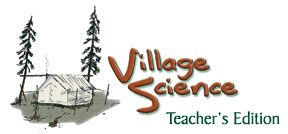To the Teacher
|
Teacher Edition Contents
Skill, Tools, & Craftsmanship Cutting
& Drying Fish Shelters Wood
Stoves Travel Piloting
A Boat
|
This book is written after the first edition worked it’s way across Alaska and parts of Canada for over fifteen years. The first edition was primitive, written after my first year teaching. However, I had lived a subsistence lifestyle in the Alaskan bush for fifteen years before that. I have rewritten almost every word, but the concepts and applications remain the same. While this new effort reflects the best that I can currently offer, I hope many people receive it as inspiration and go on to surpass me in all regards. TextThe textual materials are straightforward. I could have embellished more, explained more, included more verbage, but instead I chose to be concise. In that regard, I have sometimes oversimplified. My goal at this time is to inspire students to find science in their local environment. It is not to be the last step on the way to Harvard. You will find much information in the text that is nowhere else in print. Please feel free to validate or invalidate that information in your community as you interact with the knowledge base of that community. ActivitiesMy intention was to drive the students into the community with the questions that will prompt meaningful discussion with the local experts and elders, stirring memories. This is where most of the learning will take place in each lesson. All of the activities have a specific purpose, a fact, a concept or principle behind the directive. I have included in this teacher’s edition some tips and hints for the activities, but hopefully your local situation will create greater insights than I have to offer. Caution: There are few activities that do not have potential danger. They reflect village life which is full of hazards. Rather than avoid them, this book provides the teacher with the opportunity to stress safety. I haven’t identified all the hazardous activities or this book would be quite a bit longer. Use caution in every regard, particularly with gasoline. Student ResponsesThese questions are basic recall and comprehension, straight out of the text. The teachers’ answers are printed in a separate booklet. If you did not receive the booklet with this publication, contact the Alaska Native Knowledge Network, P.O. Box 756730, Fairbanks, Alaska 99775-6730. MathSome of these questions are quite hard. They are real-life questions that might have to be modeled on the board. Many will require higher-level math skills than the students have. Some might require higher level math skills than the teacher has. Most of these are real life problems I wrestled with in thirty-three years of living in the Alaskan bush. How to use this bookIt is possible to read a chapter and do the questions at the end just like any other text. However, I think the essence of this book lies in the activities. There is no particular order in which these lessons need to be done. However, I would recommend that you consider the seasons, saving outboard motors for the spring, and doing winter trails at the appropriate time. It would be good to do all the components of engine lessons at the same time, as they make up a whole. They aren’t vod ed lessons. Each one is embedded with science concepts and locally relevent knowledge. Physical vs. Life sciencePhysical sciences are not more important than the life sciences, but are a healthy prerequisite. It is easy to understand the burser in a caribou joint after studying friction on a larger scale. It is easy to understand why rabbits have long intestines when the concept of surface area is part of one’s reality. Knowing physical science concepts takes life science efforts out of the realm of memorization and places it in the realm of understanding and application. Thematic teachingScience can be the core of a fun-filled day, month, or school year. Writing, math, social studies, art, and other subjects are easily woven in and through the life process that is known as discovery, or more formally, science. Thank you for using this book. My hope is that your life and the lives of the students will be changed by it, opening up further the realm of using the local environment to explore science. Sincerely, Alan Dick |
